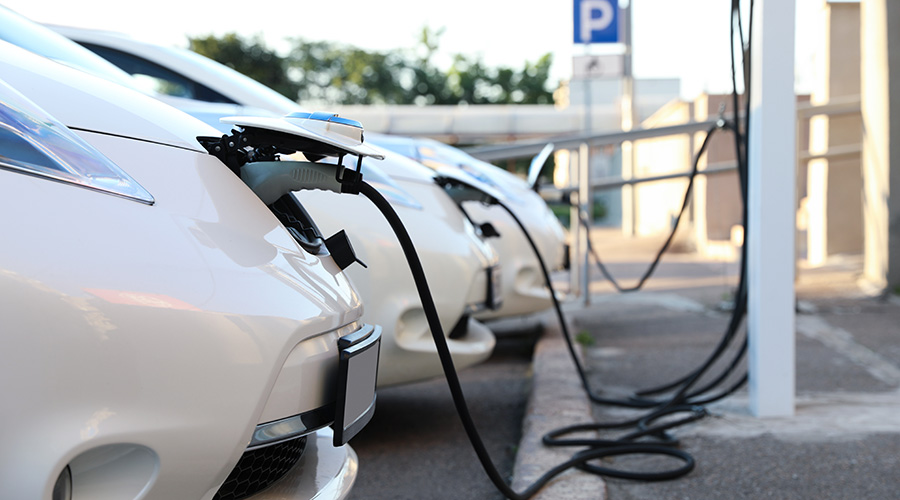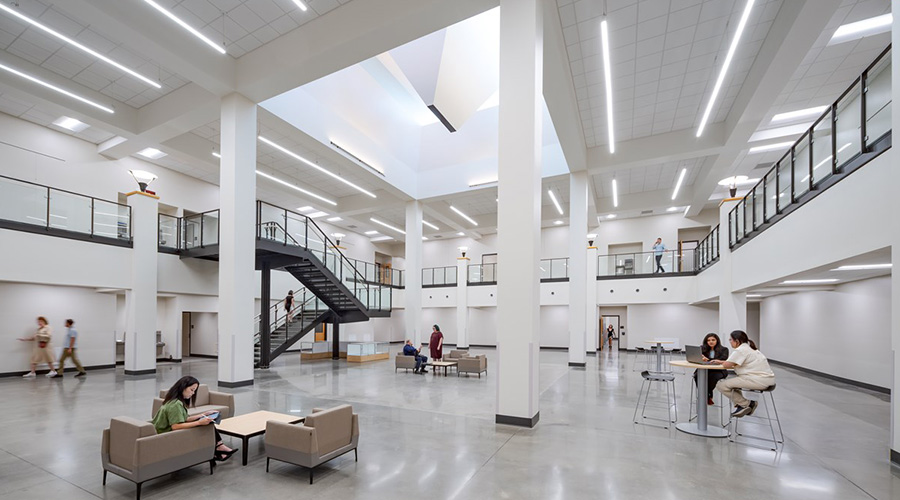Energy Efficiency Prescriptions for Health Care Facilities
A nine-point check up can help health care facility executives find significant opportunities for savings
Health care construction is booming. Multistory steel skeletons are being fleshed out in large metropolitan areas and small cities across the country. So many hospitals and medical centers are being built that capital investing for health care construction is expected nearly to double in the next few years, from about $18 billion in 2006 to about $35 billion in 2010.
Many factors are driving these large capital investments, including a lack of investment during the 1990s, an aging population and critical bed shortages. With so much new and replacement construction underway, the time to take a look at energy strategies for hospitals is now.
The energy consumption of hospitals isn’t a pretty picture. Hospitals average 2.7 times the gross energy use intensity of office buildings, according to the Commercial Buildings Energy Consumption survey (2003), published by the U.S. Energy Information Administration. Equally troubling: Of the more than 3,600 LEED-registered projects in the United States, only about 2 percent (74) are health care buildings, according to the U.S. Green Building Council.
There are many reasons why hospitals are so energy-intensive. Hospitals operate 24 hours a day and aim to provide patient comfort and optimum health care at the push of the emergency call button. And hospitals are bound by stringent medical standards and ventilation requirements.
“Hospitals have higher requirements for outside air, more heating, cooling, dehumidification and humidification than other building types,” says Farhan Khatri, project manager of engineering at Marshall Erdman & Associates. “As a result, their energy consumption will be higher.”
New technology has set the energy meter spinning even faster. Modern hospitals include sophisticated pieces of medical equipment such as magnetic resonance imaging (MRIs) and minimally invasive robotic surgery units that are major energy users.
“In patient rooms particularly, technology was flat for years,” says Steven Juett, director, clinical systems planning for health care technologies at RTKL. “It was basically a room with air conditioning and lighting, maybe a phone and a television. Now, medical technology is moving into the patient room with monitoring equipment, electric beds, computerized medicine and Internet connections.” These new technologies are turning patient rooms into major energy consumers.
Operating rooms also are large power consumers both in environmental controls and equipment demands. Monitors allow microscopic viewing of delicate surgical operations, robotic surgery and integrated supporting equipment. “The modern hospital doesn’t have 100 computers, it has thousands,” says Juett. These small individual energy users add to the internal load of today’s hospital building.
Experts in health care design and construction suggest starting any energy strategy by closely examining three areas — HVAC, lighting and hot water. Together, they account for 60 to 80 percent of a hospital building’s energy use. Many of the nine energy-reduction strategies they discussed focus on aspects of these three elements.
1. Start with Holistic Design
Modern medicine focuses on the whole person — mind, body and spirit. New hospitals also benefit from that holistic perspective, particularly in the early design stages.
The holistic approach begins with an early model of the hospital concept that evolves in the earliest building team discussions, long before an architectural rendering of the hospital is put on paper. Ideally, those early discussions include engineers, designers, hospital management and facility executives, who will be making sure the building performs as it is designed to.
“To push for more energy efficiency, we have to make sure everyone understands how that is being achieved,” says Jeffrey Bodway, electrical health care team leader for SSOE Inc. “We have to have a buy in for the program from the hospital administrator on down,” he says.
2. Model Energy Performance
To achieve efficiency, facility executives must understand how each element of the hospital interrelates. Today’s user-friendly energy software makes it easier to analyze interactions. “When engineers are involved very early in the design concept, we can evaluate multiple options, their paybacks and costs in a day’s time,” says Khatri. “Then a client gets the right system for the project.”
For example, by starting early with a model of the hospital building, the design team can analyze different building orientations and apply different HVAC systems to see which works best. “When you design in a holistic manner, you can take full advantage of an HVAC system’s available energy by matching the source to the loads,” says Roger Lautz, associate vice president and director of mechanical engineering for the Great Lakes office of HGA.
3. Capitalize on the HVAC and BAS Systems
Today’s HVAC systems are more energy efficient than units in the past. Tim Krawetz, vice president at Syska Hennessy Group, says he sees no problem in achieving 10 percent energy savings with well-specified HVAC systems, coupled with building automation systems. “Tremendous energy can be saved by maximizing usage through such common things as chiller load shedding, two-speed fan motors, and setting controls wisely,” he says. “In fact, if facility executives are clever enough running the plant, they can achieve energy savings of 20 to 25 percent.”
Another area where significant HVAC savings can be achieved is in operating suites. Surgeons want cooler temperatures. But the lights and equipment, as well as the medical staff in the room and the operation itself, produce plenty of heat and moisture. For such situations, energy recovery wheels may help the central utility plant’s overall performance.
“To remove the humidity with a traditional HVAC system, you must subcool the air and then reheat it,” says Khatri. “In the process, a lot of energy is lost. Energy recovery wheels resolve that dilemma.”
Energy recovery wheels improve HVAC efficiency by preconditioning the outside air supply. Applying energy recovery ventilation often enables hospitals to meet ASHRAE ventilation and energy standards, while also improving indoor air quality and possibly reducing total HVAC equipment needs.
John Szekeres, mechanical health care team leader for SSOE, says he typically specifies two energy recovery wheels. One works on both latent and sensible heat loading, while the second handles sensible heat only.
4. Look at Energy Transport: Motors and Pumps
Patient and medical staff comfort depends on heating, cooling, humidifying, dehumidifying and proper outside air exchanges. To accomplish those needs, fans and pumps are running continuously, transporting air and water through the HVAC system. Large amounts of energy are spent along the way. “By targeting these transport systems, we can reduce the building’s energy consumption,” says Lautz. “We do this by reducing the flows and increasing the temperature changes to get more work out of every bit of fluid we move.”
But there is a risk in trying to push the capabilities of the heating and cooling coils. “Systems need to be set up correctly and operators must understand how the system is supposed to work,” says Lautz. “Improper control can create uncomfortable conditions. It may even reduce or eliminate the energy savings expected.” To prevent these conditions, Lautz recommends full commissioning of the system and operator training.
“The boring stuff makes a difference in controlling energy and operating expenses,” says Krawetz. He says that it is important to ensure there is a large enough facility staff to do proper maintenance on energy transport fans and pumps. “Funding for walking the mechanical room has to be in place,” he says. “It’s not buying an MRI, so hospital executives don’t see how the static pressure from build up on fan motors is costing them money.” Krawetz says these elements have to be in place so that efficiencies are maximized.
5. Examine Special Equipment Needs
As hospitals add robotics, automated pharmacy dispensers, MRIs, computed tomography and bedside patient systems, managing heat dissipation can become a challenge. How to accomplish that efficiently becomes a risk management decision. Does the medical machinery remain on the central HVAC system? If the central system is used, the hospital is paying for filtered ventilation air when the machinery really just needs air. Can a more efficient liquid cooling system be applied?
Internal heat gains of medical equipment and refrigerators may represent one-third of a hospital’s cooling load. “We can move more energy more efficiently with liquid than with air,” says Lautz. “We capture as much heat from this equipment as possible with liquid, reducing the load on the air systems. Maybe we can figure a way to take that heat back and reuse some of it for the domestic water load or to offset preheating loads. Excess can be rejected into exhaust air streams or through cooling tower systems. The idea is to reduce the amount of air we need to move and to reuse as much heat as possible.”
6. Check Water Use
Another energy user is sterilization equipment. Hospitals often use different systems, according to Juett. Each system serves its function and has its own consequences.
- Steam: In addition to the cost of producing steam, the extra moisture and heat created by the process must be addressed.
- Ethylene oxide: Ethylene oxide is toxic, so it must be neutralized.
- Plasma: When the plasma chamber is opened, no heat is released into the room.
Each sterilization method meets a specific need, Juett says. “But by analyzing the hospital’s needs for sterilization, we may be able to change the mix of these three methods and reduce total energy consumption.”
Plumbing fixtures, faucets and valves offer other opportunities. “At one time, toilets required three gallons per flush,” observes Szekeres. “Now they are down to 1.6 gallons and some are even 1.0 gallon per flush.” There also are waterless urinals and urinals that use only 1 pint of water per flush. All reduce water consumption, but they have different maintenance needs.
7. Consider Options for Shedding Light
Good hospital lighting systems — including energy efficient fluorescent ballasts, daylight controls, occupancy sensors and building automation system monitoring — often can shave 2 to 3 percent off the hospital’s overall electricity energy use, according to Bodway. Many spaces are used sporadically during the day and do not need to be lit all the time.
Another potential energy-saving lighting technology is light emitting diode (LED) lamps. “High-powered surgical lights produce a lot of heat,” says Juett. Surgical LEDs use 35 percent less energy and create more usable light for surgeons. Juett says that the lights currently carry a 10 to 20 percent cost premium, “but over the next three years that should come down.” At that point, they also may be applied in the emergency department, trauma rooms and examination areas. Even portable LEDs on goosenecks may be available for use in pediatric and gynecologic areas.
Another advantage of LEDs, according to Bodway, is that they typically last 20 years without replacement. “For hospital facilities that run lights all the time, that really cuts back on maintenance, even over fluorescent lamps. But LED technology does require a mind shift, because we’re talking about a printed circuit board, not a traditional lamp.” To show clients the potential of the technology, Bodway often uses an LED fixture and lets the client turn it on and see how it performs. “Talking and seeing lumens are two different things,” he says.
8. Think Off-site
Many energy-saving technologies require thinking off-site, as well as within the hospital, particularly when it comes to hospital data management. “Because of the rapid deployment of picture archiving and digital medical communications, the hospital data center has migrated from payroll and insurance processing to being a digital extension of the doctor,” says R. Stephen Spinazzola, vice president of RTKL.
Starting in about 2005, hospitals began experiencing a 5 to 10 percent increase in their power usage due to the computer needs of medical applications. Some hospitals have concluded that primary data management should be handled off-site, where the HVAC, humidity control and power needs can be dedicated to such essential operations. Sometimes, these data centers are shared by other hospitals within a system. Sometimes they serve one medical center.
“Off-site, we can design these centers to be energy efficient,” says Spinazzola. Hospitals today generate a tremendous amount of data, but Spinazzola estimates only about one-third is related to patient care. That crucial third is backed up at the hospital. That way, should a disaster strike at either site, patient well-being can be maintained.
9. Study the Envelope
Like cities, hospitals have heat islands. One obvious heat gain location is the rooftop. Another is along the skin, particularly in the lobby and hospital reception areas, which may be open and several stories high. So careful consideration of the medical center’s envelope is part of energy-conscious design.
“Changing the color of the roof to white can reduce heat load in the building,” says Bodway. The amount of gain varies by the building’s location and its configuration, but Szekeres estimates a reflective white roof can minimize heat gain by 5 to 10 percent.
Another way some new hospitals are cooling their rooftops is with healing gardens, says Khatri. Not only is the heat island effect reduced, “but the healing garden is still in the hospital environment. What hospitals are finding is that patients are healing better and they are having faster recoveries. Green roofs are highly effective at improving the bottom line.”
Inside the hospital, healing gardens can be passive or active. Passive systems use selected species of plants. In an active healing garden, the planted walls have air intake behind them. “The living wall works as a biofilter and removes air contaminants,” says Khatri.
The exterior envelope, particularly in the lobby area, which often soars several stories in modern hospitals, also offers opportunities for energy savings. A double-envelope design of the glass area can include a 12- to 18-inch air space between panes. Sunlight warms the glass, rising up and then being recaptured by the hospital’s mechanical system and used as preheated air. In summer months, the air pocket reduces the radiant heat into the building, lowering the cooling loads.
Rita Tatum, a contributing editor for Building Operating Management, has more than 25 years of experience covering facility design and technology.
Related Topics:











